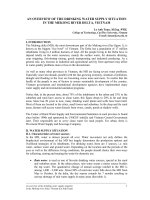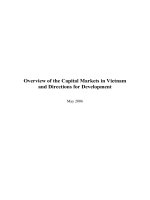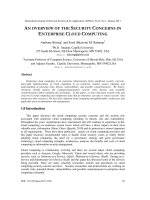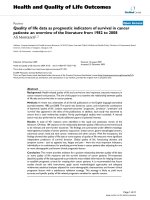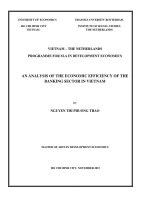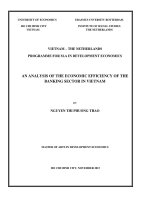AN OVERVIEW OF THE NTFP SUB-SECTOR IN VIETNAM - Full 10 điểm
Bạn đang xem bản rút gọn của tài liệu. Xem và tải ngay bản đầy đủ của tài liệu tại đây (450.34 KB, 97 trang )
Forest Science Institute of
Vietnam
Non-timber Forest Products
Research Center
Project: Sustainable Utilization of
Non-Timber Forest Products
Project Secretariat
An Overview of the NTFP Sub-Sector in Vietnam
Edited by Jason Morris and An Van Bay
Contributing authors:
Vu Van Dung
Hoang Huu Nguyen
Trinh Vy
Nguyen van tap
Jenne De Beer
Ha Chu Chu
Tran Quoc Tuy
Bui Minh Vu
Pham Xuan Phuong
Nguyen Van Tuynh
Nguyen Duc Xuyen
Hµ néi, June 2002
Cover design by the F.A.D.
Cover photo: Forest rain forest and Non-wood Forest Product in Vietnam
Permission Pub. No.:
This document has been produced with support of the NTFP project. However, the views expressed in the document
do not necessarily reflect those of the Project Secretariat or the project partners, including the Government of
Vietnam, IUCN, the Government of The Netherlands or any other participating organisation. All responsibility for
appropriate citation and reference remains with the authors.
FOREWORD
NTFPs have provided essential, supplementary, and luxury materials to human communities for
probably as long as humans and forests have co-existed. But even today NTFPs continue to play
vital roles in the livelihoods of communities living in and around forests all over the world and
have increasingly important roles in national economies, especially for tropical countries.
Documentary evidence of international export of NTFPs—from the Indonesian islands to China—
dates as far back as the 5th century (De Beer & McDermott, 1996). In the past couple of
centuries, governments, traders and scientists have collected and compiled extensive information
on NTFPs, particularly for the purposes of extraction and trade among colonial regimes. As
Neumann & Hirsch (2000) say, “by the end of the 18th century, a global network of naturalists and
institutions was in place that was able to acquire and disseminate knowledge of economically
useful tropical plants” (p.3).
The past couple of decades has seen a reinvigorated interest in NTFPs, particularly in light of
their potential contributions to forest and biodiversity conservation; poverty alleviation and
upland development; and women and ethnic minority groups in development. NTFPs can be
harvested sustainably with low-impact on forests, provide important sources of income and
subsistence materials to communities living in and around forests (often poor, upland and/or
ethnic minority communities, and the primary collectors are often women) and, as such, provide
important incentives for local conservation and management of these forests and their
biodiversity. Indeed, the overlap of NTFPs into each of these domains has given promise to
efforts for integrated conservation and development. The enormous success of certain NTFPs on
international markets, such as rattan and bamboo, has also created interest in their potential
contributions to local and national economies.
Vietnam shares many of these concerns. Among the Government of Vietnam’s top priorities are
national economic growth, poverty alleviation (particularly for upland communities and ethnic
minority groups) and forest conservation, as evinced in the recent Forest Development Strategy, 5
Million Hectare Reforestation Program and Comprehensive Poverty Reduction and Growth
Strategy. However, the NTFP sub-sector is still budding in Vietnam. Many of the tasks for
NTFP research and development have been dispersed among offices and departments under the
Forest Sciences Institute of Vietnam (FSIV, under the Ministry of Agriculture and Rural
Development [MARD]) and a small research centre for “forestry specialty products” (which is
loosely translated in this document as the “Non-Timber Forest Products Research Centre”) in the
laboratory and pilot sites through the case studies.
In 1998, MARD, through the Non-Timber Forest Products Research Centre (NTFP-RC) and
IUCN-Vietnam and with funding from the Royal Netherlands Embassy, embarked upon an
integrated conservation and development project for the Sustainable Utilisation of NTFPs, whose
primary aim was to build-capacity for the NTFP-RC. Through the course of implementation, the
NTFP Project played a key role in generating an understanding of the NTFP sub-sector, including
the production of a sub-sector analysis (De Beer, Ha Chu Chu & Tran Quoc Tuy, 2000), policy
review related to NTFPs (Bui Minh Vu, Pham Xuan Phuong, Nguyen Van Tuynh & Nguyen Duc
Xuyen, 2001), development strategy for the NTFP-RC (Do Dinh Sam, Nguyen Van Tuan & Le
Thanh Chien, Guido Brokhoven, Chun K. lai and Gary King) and by providing key inputs into the
Forest Sector Support Program and its consequent Forest Development Strategy (see the NTFP
Project’s external evaluation by Le Thac Can, Huynh Tuu Boi & Vu Ngoc Long, 2001).
The current sub-sector review is based on a previous sub-sector analysis (De Beer et al., 2000),
the policy review (Bui Minh Vu et al., 2001) and an overview of NTFPs in Vietnam (Vu Van
Dung, Hoang Huu Nguyen & Trinh Vy, 2002). The book begins with Part I, which mainly
describes and analyses the current situation of the NTFP sub-sector and its legal framework in
Vietnam.
Chapter 1 introduces the debates over definitions and classification of NTFPs,
followed by an overview of the major constraints and potentials to NTFP production and
development in Vietnam. Chapter 2 gives a brief history of government institutions responsible
for NTFPs and reviews the capacities and potentials of major stakeholders and institutions.
Chapter 3 provides an extensive review of the legislative and legal framework, particularly as
they relate to the inputs and outputs of NTFP production. Finally, Part II is dedicated to profiles
of various NTFP species under different categorizations that are currently and/or traditionally
important to Vietnam.
The compilation of this book has tried to combine creating a comprehensive and coherent
overview of the NTFP sub-sector, while maintaining the integrity of individual authors’
contributions. This was accomplished by basing each chapter on the authors’ previous work,
supported with contributions from others and the editors’ commentary, as appropriate. However,
conglomeration of these various voices and the starkly contrasting styles of the authors does not
always make for fluid reading, especially from chapter to chapter. De Beer et al.’s style is as
succint and analytical as Bui Minh Vu et al.’s style is encyclopaedic and descriptive. Vu Van
Dung et al.’s focus on products and classifications adds yet another dimension to style. Thus, the
book is presented for two types of readers, as a cover-to-cover read for the very interested reader
in NTFPs or on a pick-and-choose basis for those with more specified interests.
On the whole, I believe that the combined work of these authors has produced a substantial—and
first—introductory document to the issues, potentials and constraints facing the development of
the NTFP sub-sector in Vietnam.
Prof. Dr. Do Dinh Sam
ACKNOWLEDGEMENTS
We would like to extend a special thanks to Nguyen Minh Thong, Prof. Do Dinh Sam, Mr. Guido
Broekhoven and Dr. Le Thanh Chien for providing an opportunity for development this book and
for guiding us through the process. Thanks to the NTFP Research Centre staff for their kindness,
assistance, and cooperation.
Thanks to Justin Fong and Pham Trong Hien for assistance with English and Vietnamese
language editing and document formatting
ACRONYMS
ADB
BAROTEX
BRDC
CITES
CREDEP
DARD
FAO
FIPI
FSIV
ICDP
IEBR
IUCN
MARD
MFor
MPRC
NaForimex
NedCen
NITM
NTFP
NTFP-RC
NWFP
RTCCD
SIDA
SIERES
SNV
SFE
UNDP
UoH
VFGD
WWF
Asian Development Bank
Bamboo Rattan Export Company
Bee Research and Development Centre
Convention on International Trade of
Endangered Species
Centre for Research and Development of Ethnomedicinal Plants
Department of Agriculture and Rural
Development
Food and Agriculture Organisation
Forestry Inventory and Planing Institute
Forest Sciences Institute of Vietnam
Integrated Conservation & Development Project
Institute of Ecology and Biological Resources
International Union for the Conservation of
Nature and Natural Resources
Ministry of Agriculture and Rural Development
Ministry of Forestry
Medicinal Plant Research Centre
National Forestry Import-Export
Non-state Economic Development Centre
National Institute of Traditional Medicine
Non-Timber Forest Product
Non-Timber Forest Products Research Center
Non-Wood Forest Product
Hanoi Research and Training Centre for
Community Development
Swedish International Development Agency
Sub-institute of Ecology, Resources and
Environment Studies
Netherlands Development Organization
State Forest Enterprise
United Nations Development Program
University of Hanoi
Vietnam Forestry General Department
World Wildlife Fund
Contents
Foreword……
Acknowledgements………
Acronyms…………
Part I. NTFP sub-Sector in Vietnam…….
1. An introduction to NTFPs in Vietnam
Part I. Non-Timber Forest Products Sub-Sector in Vietnam
2
1
An Introduction to NTFPs in Vietnam
By Vu Van Dung, Hoang Huu Nguyen, Trinh Vy and Nguyen Van Tap; and Jenne de Beer, Ha
Chu Chu and Tran Quoc Tuy
1.1
Introduction 1
Non-Timber Forest Products (NTFP) comprise various groups of products derived from
forests, including rattan, palm leaves, bamboos, medicinal plants, oils and resins, tannin, dyes
and products from wild fauna. Despite long-standing use of NTFPs by communities living in
and around forests, governments and businesses worldwide tended to view forests
predominantly as timber resources and neglected NTFPs. In the past half-century,
exploitation and use of NTFPs have increased, contributing to industry and modern subsectors such as electronics.
In addition, NTFPs have important social and economic values, especially to mountainous
peoples in developing countries, who often depend on NTFPs for income and sustenance.
NTFPs have created job opportunities for hundreds of thousands of people in mountainous
areas and contributed to hunger eradication and poverty alleviation in Vietnam. NTFPs also
contribute to protecting human health, the environment and biodiversity resources.
This chapter begins by presenting different definitions and categorizations of NTFPs and the
debates surrounding them. Then it provides an overview of the issues and constraints facing
development of NTFPs in Vietnam.
1.2
Definition
Several definitions exist of what is a Non-Timber Forest Product (NTFP), or sometimes called
Non-Wood Forest Product (NWFP). In simple terms, these definitions refer to all products
that people harvest from forests, excluding timber or wood. “Wood” refers to the stem,
branches and roots of trees characterized by lignified, water-conducting, strengthening and
storage tissues. “Timber” is composed of wood in forms suitable for heavy construction,
sawn wood or that exceeds a specified width and thickness (Chandrasekhan, 1995). Thus,
according to the latter definition, NTFPs includes fuelwood, carving wood, pulp, and small
wood for light construction.
The Asia and Pacific NWFP Expert Consultation held in Bangkok in 1991 proposed the
following definition:
NWFPs forest products consist of all biologically renewable products, except timber,
fuelwood and charcoal. NWFPs are harvested from forests, forested lands and
arboreal plants. Therefore, other products such as sand, rock, water and eco-tourism
are excluded from NWFPs.
1
Sections 1.1,1.2 and 1.3 are by V u V an D ung etal.
3
This group of experts emphasised that eco-tourism is not an NWFP, in opposition to
arguments that NWFPs include forest-derived services such as fishing, camping, wildlife
watching and excursions (Chandrasekhan, 1995).
Recently, J.H. De Beer, a widely cited author on NTFPs, gave this definition:
NTFPs are comprised of biological resources derived from raw materials that are
non-timber and harvested from forests for human use. They may consist of foods,
medicines, spices, essential oils, resins, milk, tannin, dyes, ornamental plants, wild
animals (live animals or their products), fuelwood, and other raw materials such as
bamboo, rattan, small arborous and fibrous plants.
Notably, De Beer includes fuelwood among NTFPs.
In June 1999, this definition was offered at a conference sponsored by the Food and
Agriculture Organization (FAO):
NTFPs consist of biological resource derived products that are non-timber, harvested
from forests, forested lands and arborous trees.
In sum, the term “NTFP” is difficult because “it is defined not by what it is, but by what it is
not” and is often of little help as an analytical category because of the immense variety among
NTFPs (Neumann & Hirsch, 2000, p.1-2). What remains important is the term’s specific
recognition of a multitude of forest products and/or their uses that are often ignored by
businesses and government (in favour of industrial timber), but can play important roles in
national and local economies, forest and biodiversity conservation, poverty alleviation and
upland development, and women’s and ethnic minority issues.
1.3
NTFP Classification
There are various NTFP classification systems worldwide. Some have been developed on the
basis of life forms of floral species producing their products, such as timber trees, shrubs,
herbs, climbers and lianas, etc.; and others have developed on the basis of their original
distributions.
The NTFP classification system adopted at the Bangkok Conference (FAO, 1991) consisted of
six categories:
1. Fibrous products: bamboo, rattan, fibrous leaves and trunks and grasses
2. Food products:
a. Vegetable based products: trunks, buds, roots, tubers, leaves, flowers,
fruits, nuts, spices, oil seeds and fungi
b. Animal products: bee honey, wild meat, fish, snails, clams, edible bird
nests, eggs, edible insects
3. Vegetable based drugs and cosmetics
4. Extractive products: gums, resin, oleoresin, latex, tannin, dyes, fat oils and
essential oils
4
5. Animals and non-edible animal products: mulberry silk, live animals, birds,
insects, hairs and feathers, skins, ivory, horns, bones and shellac (red lac-insect
resin)
6. Others (e.g., bidi leaves, which Indians use to wrap tobacco)
Four years later, Chandrasekharan (1995), an NTFP expert for the Food and Agricultural
Organization (FAO), proposed a classification system of these four major categories, each
with its own sub-categories:
1. Live plants and their components
2. Animals and animals’ products
3. Processed products (spices, vegetable oils and resins)
4. Forest derived services
Prior to these international efforts, the “List of Special Forest Product Species Under Sectoral
Unified Management,” attached to Decree 160 (12/1984) on the unified management of
specialty forest products, was the first NTFP classification system to be formally recognised
in Vietnam. The list classifies NTFPs into two major categories, Forest Flora (Category 1)
and Forest Fauna (Category 2). Each of these categories is divided into sub-sections, as
follows:
Forest Flora
•
Resin, essential and fat oils, and tannin trees (e.g., pine, cinnamon, anise, cajuput,
mangrove, canarium, eucalyptus, benjoin)
•
Medicinal plants (e.g., including Morinda officinalis, Amomum spp, Homanolena
occulta, Polygonum multiflorum, Codonopsis javanica, Eagle wood, Fibraurea
recisa)
•
Trees/ plants used as raw materials for handicrafts (e.g., rattan, bamboo, Corypha
lecomtei, etc.)
•
Trees/ plants used for industrial materials (e.g., shellac, pine resin, gums)
Forest Fauna
•
Wild animals harvested for leather, feathers, bones, ivory, flesh, musk, nectar and
pharmaceutical products (e.g., elephant, tiger, panther, wild buffalo, wild ox, deer,
python, snake, giant lizard, gecko, monkey, gibbon, porcupine, wild bees, precious
birds, and other animal species)
•
Products processed from the raw materials that are derived from animals
Despite the erroneous inclusion of shellac (processed from resin of red lac insect) under floral
products, the NTFP classification system testifies to the progress in the understanding of
NTFPs in Vietnam.
5
Other categories of NTFPs important to Vietnam, but not specifically identified in the above
classification systems are 1) species of trees/ plants containing toxic substances, 2) ornamental
plants and 3) wrapping leaves for food and other products.
1.4
Issues and constraints to NTFP production and development in Vietnam 2
This section gives short descriptions of the NTFP sub-sector in Vietnam and identifies fields
of interest to different groups of stakeholders. The section is based on semi-structured
interviews with key informants representing different organizations and government
institutions during a period of consultancy for which the authors were employed.
1.4.1
Nature of the NTFP sub-sector
Rural households and upland communities
The importance of NTFPs to rural households in Vietnam cannot be overestimated. This
applies in particular to the 8.5 million people of ethnic minorities, who mainly live in upland
areas. In these societies, gathering, hunting and fishing are traditionally all vital adjuncts of
forest farming. Despite sweeping socio-economic changes of modern times, particularly the
increased availability of manufactured and other substitute materials, NTFPs continue to play
an important role in the livelihood of ethnic minorities and rural households.
This is particularly true for poorer and more remote households with less access to the
advents of modernity. As shown in a study with Dzao and Tay communities living in
the mountainous areas around Ba Be National Park, fuelwood, bamboos, fodders,
forest vegetables, basic medicines and a variety of other life-enhancing products (e.g.,
ornaments, aromatic substances, teas) continue to provide essential and supplementary
materials for livelihoods (Morris, 2002). Table 01 shows how NTFPs continue to
contribute to the cultural and spiritual life of Tay communities, as indicated by the variety of
ingredients used to make specific types of cakes for celebrating festive occasions. Many of
Tay festivals have become integrated with Kinh festivals. Ones that are distinctly Tay are
indicated with an asterisk.
Table 01. Tay festivals and the NTFPs used to celebrate them
Name of festivity
Tet (Lunar New
Year)
Dap noi*
Date
1/1
Name of cake
Peng Ben cake
NTFP ingredients
Rush leaf
30/1
Peng Khi Ma cake
So slam
3/3
Sticky rice with anteggs
Banh troi cake
Banh chay cake
So ha
Srip shi/Srip ha
buon chat (Midyear festival)
5/5
15/7
Peng Khun cake
Pinnate leaf cake
Banh Khuc cake
Banana cake
Banana root cake
Pinnate leaf, yellow daisy, artemisia
vulgaris leaf, gnaphalium affine leaf
Ant larvae, dyes for sticky rice
(liquidambar formosana leaf for black,
orange leaf for red, mormodica
cochininensis fruit or saffron root for
yellow, ginger leaf for blue)
Thysanolaena latifolia
Pinnate leaf
Banana leaves
Dried banana
Dried forest-banana roots
2
Section 1.4 isby D e Beeretal.
6
Ram trung thu
(Autumn moon
festival)
So cau*
15/8
New rice festival*
10/10
Fruits
Banana, grapefruit, persimmon
Peng khau mau
Banana leaf
Peng dec
Young sticky rice
Young bamboo culms
Source: Morris, 2002
Finally, NTFPs can create important economic opportunities for communities in remote
mountainous areas, with often simple technologies for collecting, planting and pre-processing.
For example, households in Bac Ha District in Lao Cai have begun to grow Amomum
aromaticum, harvesting on average 200-300 kg of fruit per year and, in some cases, as much
as 500-1000 kg. The latter is equivalent to 20-40 million VND, which is 10-20 times higher
than rice cultivated on the same area, according to the market current price of 70,000-150,000
VND per kg (Nguyen Van Tap, 2001).
Trade
The NTFP sub-sector as a whole, including collecting, cultivation, trade and processing, gives
employment to hundreds of thousand of people, including inhabitants of urban areas (Van
Tien 1991:14). A significant part of the NTFPs harvested is entering the home market for
direct consumption or for use in industries, which produce for the home market. It is
impossible to assess the real total value of NTFP exports from Vietnam because most of it,
including a large volume of endangered plant and animal species, leaves the country
unregistered (see Donovan, 1998). The picture is further complicated by the fact that a
considerable part of Vietnam’s NTFP export is in fact re-export from Laos and Cambodia.
The overall trade is in the hands of a few state and provincial companies and numerous small
private traders (see further Raintree, 1999; De Beer, 1992).
However, some statistics on trade and production are available from major NTFPs. Table 02
testifies to the large volumes of NTFPs harvested annually in Vietnam. Even these statistics
are likely much less than actual volume because they exclude large amounts harvested by
households and individuals.
Table 02. NTFPs harvested from 1995 to 1999
Products
Bamboo
Neohouzeaua
dullooa
Phyllostachys spp.
Rattan
Pine resin
Anise fruits
Cinnamon
Bamboo shoots
Unit (trees)
Thousand stems
Thousand stems
1995
67,026
108,500
1996
720,858
104,779
1997
174,189
105,175
1998
172,649.5
248,310.2
1999
171,000
150,000
Million stems
Tons
Tons
Tons
Tons
Tons
15,600
28,500
5,350
1,870
7,790
32,500
24,664
25,975
1,348
6,672
3,658
30,887
2,649.2
25,639.2
6,387.3
9,896
3,954.2
13,789
12,197.3
80,097,2
6,776.8
9,500
2,100
?
100,000
65,700
7,182
5,000
2,900
?
Source: MARD, Ha Chu Chu, 2001
7
Through export and processing of NTFPs, each year MARD and Ministry of Health
contribute over 1.5 billion USD to total national exports (see Table 03). According to these
figures, the total value of NTFP exports exceeded that of exports in fisheries, which was third
only after petroleum and textiles.
Table 03. Value of Vietnam’s NTFP exports in 1996
NTFP products
Bamboo
Rattan
Cinnamon (in bark and powder)
Essential oils
Turpentine and rosin
Mushroom
Pharmaceuticals (originated from
medicinal plant and animal)
Total
Total value (million US$)
37.6
119.0
95.6
312.5
49.6
206.5
689.9
Share
2.5
7.9
6.3
20.7
3.3
13.7
45.6
15.107
100.0
Source: Ha Chu Chu, 1996
NTFPs also provide important input materials for Vietnam’s industrial sub-sectors,
particularly paper industries. The national government intends to develop one million
hectares of forest to supply raw material for 0.5 million tons of paper and pulp by 2005, and
around 2.0 - 2.5 million tons for 2010Among it there is 30% production by bamboo materials.
Pine oleoresin plants have an estimated capacity of 5,000 tons per year, and essential oil
factories are to be developed in the future. Results from the past 20 years show that
plantations for pine resin (Pinus merkusii) have increased twofold (from 30,631 ha in 1980 to
74,929 ha in 1997), anise (Illcium verum) plantations have expanded by five times (from
2,678 ha in 1980 to 14,133 ha in 1997), and cinnamon (Cinnamomum cassia) plantations have
increased by 11.5 times (from 5,353 ha in 1980 to 61,820 ha in 1998).
Furthermore, 88 bamboo-processing and 36 rattan-processing enterprises have been
developed (see Annex A).
During the last ten years, traditional craft villages have been rehabilitated and developed
rapidly, with an annual growth rate of 8% per year. 1,450 craft villages exist nationwide
(Nguyen Quang Trung, 2001). Many of these villages depend on NTFPs for raw materials,
particularly bamboo and rattan. Because handicrafts are often labour intensive, bamboo and
rattan processing alone has created an estimated 200,000 - 400,000 jobs.
The forest resource
In the past, Vietnam disposed of vast forest reserves of different types characterized by high
species richness. About 12,000 species of plants are estimated to occur in Vietnam of which
only 7,000 have been described, while up to 1,000 plant species are known to be endemic to
the country (Vo Quy, quoted in Ministry of Forestry, 1991:42). There are more than 11,000
vascular plant species, 1,000 moss species, 2,500 alga species, 826 big mushroom species,
276 animal species, 828 bird species, 258 reptile species, 82 amphibian species, and 3109
fresh water and salt water fish species, 1340 insect species. While conducting an inventory in
a standard plot of closed-canopy tropical evergreen forest — a high value forest type in NorthCentral Vietnam — there were over 100 timber species and over 100 shrubs, herbs, climbers
and secondary plants, including many NTFPs. At the moment, the use of more than 6000
8
plants has been identified in Vietnam. Vietnam's richness in biodiversity is mirrored in the
plethora of NTFPs collected for manifold purposes from the country's forests (see Petelot,
1952).
However, in the last decades the total area under closed forest cover has declined rapidly.
There is much debate over the main causes of deforestation, but they are most commonly
attributed to logging, agricultural expansion, and shifting cultivation. Shifting cultivation was
a major cause of deforestation by lowlanders who got involved in upland agriculture in large
numbers and whose agricultural practices were inadequate for upland plots. Forest decline
and other factors are leading in many locations to over-exploitation of NTFP resources in the
remaining areas, and to a decline in the abundance and quality of those resources (i.e.,
decreasing forest biodiversity) with consequent hardship for rural populations.
Interest in NTFP development
Since independence, there has always been occasional interest in NTFP development among
policy makers, foresters and scientists in Vietnam. However, these products were defined as
'minor forest products' and as such also got minor attention. Furthermore, NTFPs were almost
exclusively approached for their potential contribution to the national economy, especially for
industrial use and as a source of export revenue. From this perspective, primary concerns
were to secure sufficient supply of raw material; improve post-harvesting technology to
produce higher standards of semi-processed materials or end products; and understand better
foreign markets and the development of more sophisticated marketing skills. These concerns
still play an important role in renewed discussions relating to NTFP development. For
example, a relatively new angle from which NTFPs are approached in Vietnam—although
closely linked to the supply of raw materials concern—is incorporating selected NTFPs in
large-scale reforestation programs.
Meanwhile, interest in the potential of NTFP development is increasingly driven from other
perspectives. More recent approaches, while not necessarily antagonistic to the former, tend
to give high priority to either biodiversity conservation and/or local people's livelihood
concerns.
1.4.2
Policy development
While the different departments under MARD are involved in a heroic struggle to integrate
new and old approaches concerning NTFP development in its policies, these efforts appear to
be seriously hampered by a lack of (access to) reliable data. In addition, there seems to be a
lack of direction for further development. Different departments work with different
objectives that are not always consistent. Weak feedback and linkage with centres of
expertise in Vietnam further aggravates the situation. Some of this confusion is transmitted to
lower echelons, adding to the diversity of interpretations of national policy. There is without
doubt a crying need for general and more specific information at the policy decision-making
level. Perhaps even more urgent is the demand for expert input into the formulation process
for an all-compassing NTFP development strategy at the national level.
A detailed review of policies and the national legal framework for forestry and NTFPs is
presented in Chapter 3.
9
1.4.3
Supply of raw material
The perceived shortage of raw material of certain NTFPs is primarily a concern of enterprises
and institutes involved in processing (e.g. National Institute for Traditional Medicine). It
seems that awareness of threatening shortages often becomes a concern too late, because of a
lack of monitoring of NTFP resources, as well as a lack of contact with the primary producers,
(i.e. collectors and cultivators). The catchword for addressing the supply constraints is largescale ex situ cultivation. However, plans for encouraging the cultivation of certain assumedly
valuable species tend to be launched without previous extensive site specific trials and with
little previous consultation of farmers. Sometimes, the bottleneck may lie at the other side:
cultivation is promoted, but without previous scouting of the market and hence, the danger of
oversupply in relation to weak demand.
1.4.4
NTFPs in reforestation and forest conservation
The on-going reforestation effort in Vietnam has entered a new phase with the launch of the
“National five million hectare reforestation programme” (1998-2010). The program has been
designed and will be largely implemented by MARD. Several international donors (such as
ADB, UNDP, the Netherlands Embassy) and other international organisations (WWF, IUCN)
have established a partnership with the government to support the programme.
The agreement hase been signed between Government- Donors Partnership to commitment
on supporting to the Five Million Hectare Reforestation Programme. There are 18 donors
including Government, NGO, Instututions who has been signed on it such as EC, WB, ADB,
JBIC, UNDP, FAO, WWF, IUCN, OXFAM/GB, CARE, SNV, BIRDLIFE, FFI ( vu Van Me,
2001).
Addition, On the identification of the priority scientific research sectors on the 5MHRP, the
Parnership Group supporting programme and the participants from all level in VIetnam have
identified that the potential NTFPs on sustainable utilization sesearch, which should be top
priority on the near future ( Proceeding workshop, Nov. 2001)
Contrary to the previous national reforestation plan, the current programme contains a
substantial NTFP component, covering about 10% (480,000 ha) of the total land area affected
with a total investment of 3,620 billion VND (see Table 4).
Table 04. Planned area of NTFP Plantation in Five million hectare reforestation program.
NTFP Plantation
Cinnamon
Anise
Pine (Pinus spp.)
Bamboo
Planned areas
65,000
20,000
140,000
200,000
Source: MARD, Five million hectare reforestation program, 1997
The inclusion of NTFPs into the plan seems a positive development, as compared to earlier
large reforestation efforts, which almost exclusively focused on the planting of a few exotic
tree species. However, the range of NTFPs considered is rather small and as the plan seems
quite ambitious, one can only hope that implementation will be preceded by thorough studies
into particularities.
In protected areas (PA), population pressure and high demand for forest products are among
the greatest challenges facing forest conservation in Vietnam. NTFPs with such
characteristics as easy growth, quick harvest, and high economic value may help communities
10
living in and around forests to increase income and reduce collecting pressures. Good
examples exist of communities managing forests to cultivate Cinnamomum cassia, Amomum
aromaticum, and Illicium verum in forests. For example, if A. aromaticum had not been
grown under forest canopies, thousands of hectares of well-grown forests would have been
converted into swidden cultivation lands in Lao Cai and Ha Giang provinces. This type of insitu cultivation can both improve living standards of communities and provide them with
incentives for conserving forest (to secure their source of income), thereby integrating
conservation and development objectives.
Ex-situ cultivation of endangered NTFP species has also shown encouraging efforts. The
growing of thousands of plants of Ngoc Linh ginseng (Panax vietnamensis) in Tra Mi District
(Quang Nam Province) and Fokienia hodginsii species in Sa Pa (Lao Cai Province); and the
raising of spotted dear (Cervus nippon) in Ha Tinh, 500 sambars in Buon Ma Thuat District
(Dak Lak Province), and python (Python molorus) and crocodile (Crocodyle siamensis) in the
Mekong Delta have contributed significantly to local economies of communities around
important forest areas.
NTFPs are also seen as a key element in buffer zone management. Most projects tend to pay
some attention to NTFPs, at least on paper, but it seems that so far the effort to address NTFP
development in practice is very much at the beginning such as activities of the NTFP project
in buffer zone of Na Be National Park, Bac kan Province and Ke Go Conservative Area in Ha
Tinh Provicne and more information could be see “ Buffer Zone management in Vietnam,
D.A. Gilmour & Nguyen Van San (1999).
1.4.5
Market information and post-harvesting technology
The need for up-to-date information relating to international markets (including trends, quality
standards and access requirements) is a concern primarily expressed in trade circles, but is
increasingly expressed in 'conservation and development' initiatives, as discussed below. It is
widely felt that Vietnam is at a considerable disadvantage in this field compared to major
competitors such as China.
Another disadvantage is believed to apply to the standards of post-harvesting technology,
including storage, grading and primary processing. The main bottleneck here seems to lay in
the limited capacity for extension of appropriate technology to small and medium industries
located in the countryside.
1.4.6
Conclusion
The interest in NTFP development has slowly increased during the last decade. The interest
reflects different perspectives, as it is triggered by:
•
perceived shortages of raw material
•
increased competition from abroad
•
needed input in reforestation programs as well as needed input in efforts directed at
poverty alleviation
•
upland rural development and conservation
MARD policy documents also reflect increased interest in NTFP development, but
inconsistently and so far it has hardly affected the overall research agenda in the country. The
11
importance of NTFPs in relation to support of local people's livelihoods, as well as the need to
better understand and improve local resource management are mentioned in 'Conservation &
Development' project documents, but often with minimal allocation of expert time to address
the issues.
Table 05 summarises main concerns and needs from the perspectives of different stakeholder
groups. For this purpose, stakeholders are divided into two categories: i) those located close
to forests; and ii) those based in urban areas.
Table 05. The stakeholders in NTFP development and their major concerns
i) Near the forest base
Local communities
Local authorities
Rural development
projects
Park management
Conservation projects
Rural enterprises
ii) Urban based
Policy makers
Urban enterprises
Research institutes
Funding agencies
Main concerns & needs
Access to forest, food & income, being consulted about interventions
Strengthen the local economy, improve living conditions
Strengthen the local economy, improve living conditions
Decrease pressure on resources in national parks, nature reserves
Decrease pressure on resources in national parks, nature reserves
Access to market information, processing technology
Main concerns & needs
Access to information and input for strategy development
Supply of raw materials, product development, export markets
Able to strengthen capacities for new challenges
See projects
2
Institutional Capabilities in NTFP Research and Development
By Jenne de Beer, Ha Chu Chu and Tran Quoc Tuy with contributions from Chun K Lai, Do
Dinh Sam, Vu Van Dung, Hoang Huu Nguyen and Trinh Vy
2.1
Introduction
This chapter offers a preliminary overview of relevant expertise available in Vietnam in the
fields of NTFP-related research and development, including a general assessment of current
strengths and weaknesses. Furthermore, priority areas to be strengthened are identified and
indications are given for potential collaboration between various organisations and the NonTimber Forest Products Research Centre (NTFP-RC) under the Forest Sciences Institute of
Vietnam (FSIV).
Chapter 1 presented the demand for expert assistance in rather broad terms and as such
reflected the points of view of major stakeholder groups. The present chapter attempts to
make a breakdown of institutional capabilities in NTFP research and development that need to
be addressed in order to attain a comprehensive understanding of the potential role of NTFPs
in sustainable rural development. That understanding will eventually allow for appropriate
advice and assistance towards the concerns expressed by various stakeholders.
The chapter begins with a brief history of NTFP-related governmental institutions to provide
background for the emergence of NTFP research and development. Then, on basis of
discussions with key stakeholders, institutional capability aspects are covered in the following
areas: strategy development; basic information (biological, product information, social
economic and trade); community development; income generation; subsistence use; legal
aspects; resource management; product development and post harvesting technology. Finally,
some conclusions and recommendations are given to further research and development in the
NTFP sub-sector. 3
2.2
Brief history of NTFP related governmental institutions in Vietnam 4
The process of NTFP development in Vietnam could be divided into three periods: 1) prior to
the establishment of the Vietnam Forestry General Department (VFGD) in 1961; 2) from the
establishment of VFGD to the establishment of Ministry of Forestry (MFor) in 1973; 3) from
the establishment of MFor to the establishment of the Ministry for Agriculture and Rural
Development (MARD) in 1995, which combined the former Ministry of Water Resources,
Ministry of Agriculture, and Ministry of Forestry; and finally, 4) after the establishment of
MARD.
•
During the first period, although NTFPs were mentioned in many legal documents, NTFPrelated activities happened on a small scale, including processing, and in an isolated
manner. At that time, government and industry considered NTFPs only as secondary
products.
•
Over the second period, NTFP development took a great step in all aspects, including
policies, organisational arrangement, cultivation, research, processing, and trading. A
separate division, directly under VFGD, became responsible for formulating policies and
monitoring NTFP development. The most noticeable development was the presence of a
3
4
To consultthe fulldocum entofthe sub-sectoranalysis and details ofits m ethodology,see D e Beeretal.(2001)
Section 1.2 isby V u V an D ung etal.
